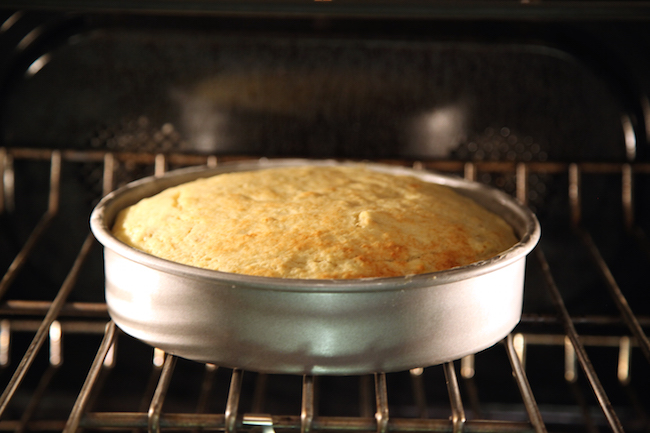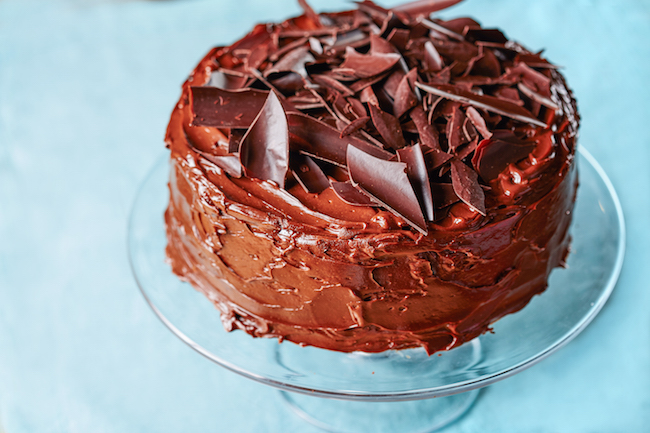
Whether it’s a birthday, a holiday like Christmas and Halloween, or just a regular ol’ Monday, cake is a must-make dessert. But let’s be real: very rarely is a whole cake eaten at once, so it’s super important to store it right for fresh leftovers. Here’s how to protect your sweets from heat and humidity.
How to Store a Cake Before Decorating

If you’re baking ahead, you’ve gotta keep that naked cake fresh until it’s ready to pretty up. Let the cake cool completely — if you wrap it while it’s warm, you’ll end up with steam, which isn’t conducive to freshness. Once the cake is at room temperature, wrap tightly with plastic. Don’t wrap it on top of a plate or platter, and be sure the plastic seals in all sides.
Pro Tip: For cupcakes or loaf cakes, you can use a freezer-type bag with a seal, assuming everything fits and the seal closes securely.
The cake can be kept in a dry place at a cool temperature for a few days. If you live somewhere with a hot or humid climate, place the cake in the refrigerator for up to three days — just be careful to wrap it well so it doesn’t absorb other odors (unless you want your cake to smell like leftover Chinese takeout).
Cake will also keep in the freezer for up to a month. Just allow ample time for thawing before using.
Pro Tip: Factor in the fillings. Even if the cake itself can sit out at room temperature, you’ll need to refrigerate it if the filling requires this (for example, if it’s filled with a pudding or custard).
Buttercream and Fondant

Believe it or not, covering a cake with buttercream or fondant helps seal in moisture. So once frosted, a cake can stay fresh in a keeper or under a large overturned bowl for up to four days.
If the weather is hot or humid, store the cake in a fridge. But be careful when refrigerating cakes with tinted fondant: condensation caused by rapid changes in temperature can make the colors bleed. If possible, transfer the refrigerated cake to an air-conditioned space and let it adjust for a while before taking it out into a warm day to reduce “temperature shock.”
Pro Tip: If there are tinted pieces to the cake you worry may bleed, you can the cake but leave it unadorned. Then just add any delicate decorations on the day of your event.
These cakes can be frozen, but you’ll need to be mindful of condensation here as well and bring them back to room temperature slowly. Do this by transferring the cake to the refrigerator so it can thaw gradually, then to an air-conditioned space.
Pro Tip: If your cake is stacked with tall tiers, consider icing and storing it in separate layers, then assembling them on the big day.
Cream Cheese or Whipped Cream icing
If there’s cream cheese or whipped cream (even stabilized whipped cream) in your icing, do not leave the cake out at room temperature. Instead, cover it and place in the refrigerator for up to three days.
You can freeze cream cheese icing, but freezing whipped cream icing alters the texture (and not for the better).
Boiled Icing
Cakes topped with French buttercream or Italian buttercream are fine when stored at room temperature or refrigerated, but don’t freeze them: the frosting turns gummy when thawed.
Ganache
For cakes topped with ganache, follow the same rules as buttercream and fondant and refrigerate ‘em, freeze ‘em or store ‘em at room temperature.
Sliced Cake
Already cut your cake? Now you’ve got a real race against the clock!
One trick for keeping things fresh: reseal the cake by spreading icing all over the cut side. You could also place a sheet of plastic directly onto the sliced edge, making sure to cover the exposed edges completely. Then wrap as needed.
Wedding Cake
It’s tradition to store a piece of wedding cake for the couple to enjoy on their first anniversary, so you have to make sure it lasts.
Place the cake in the refrigerator so the icing can set, about 30 minutes. Once it’s firm, cover with plastic wrap so it’s completely sealed. Fortify this packing by wrapping with a layer of aluminum foil, then put the whole thing in either a freezer bag or an airtight container.
Stale Cake
When tragedy strikes, don’t stress — you can still use that leftover cake. You can’t go wrong with blending cake crumbles with buttercream to make cake pops, or mixing it into an ice cream shake.

Share tips, start a discussion or ask one of our experts or other students a question.
Already a member? Sign in
No Responses to “Cake Decorating Basics: How to Store a Cake”